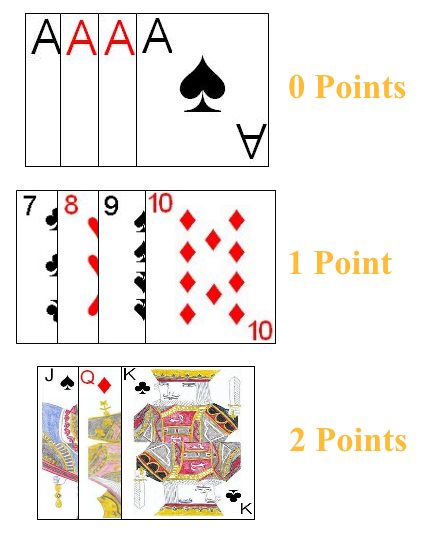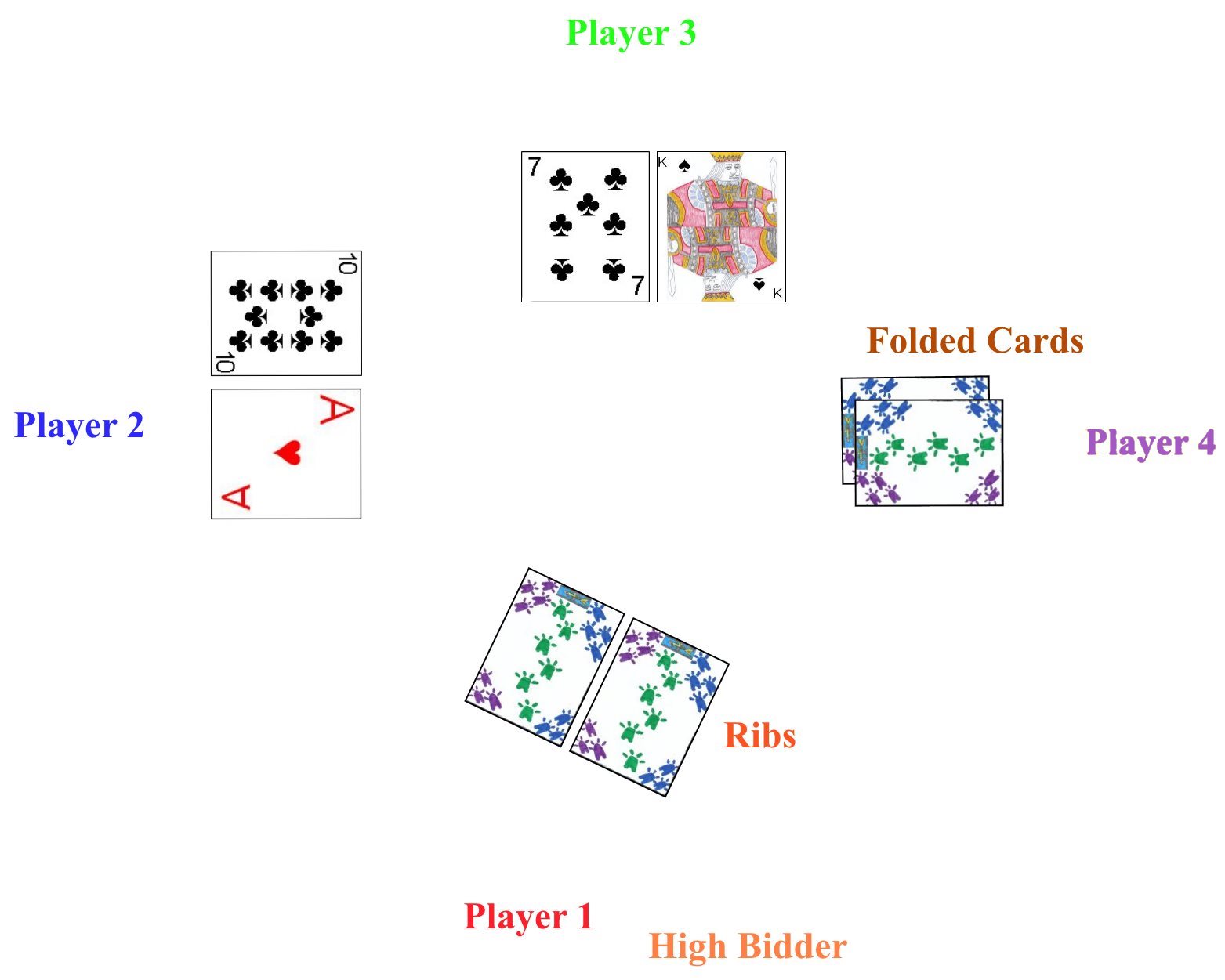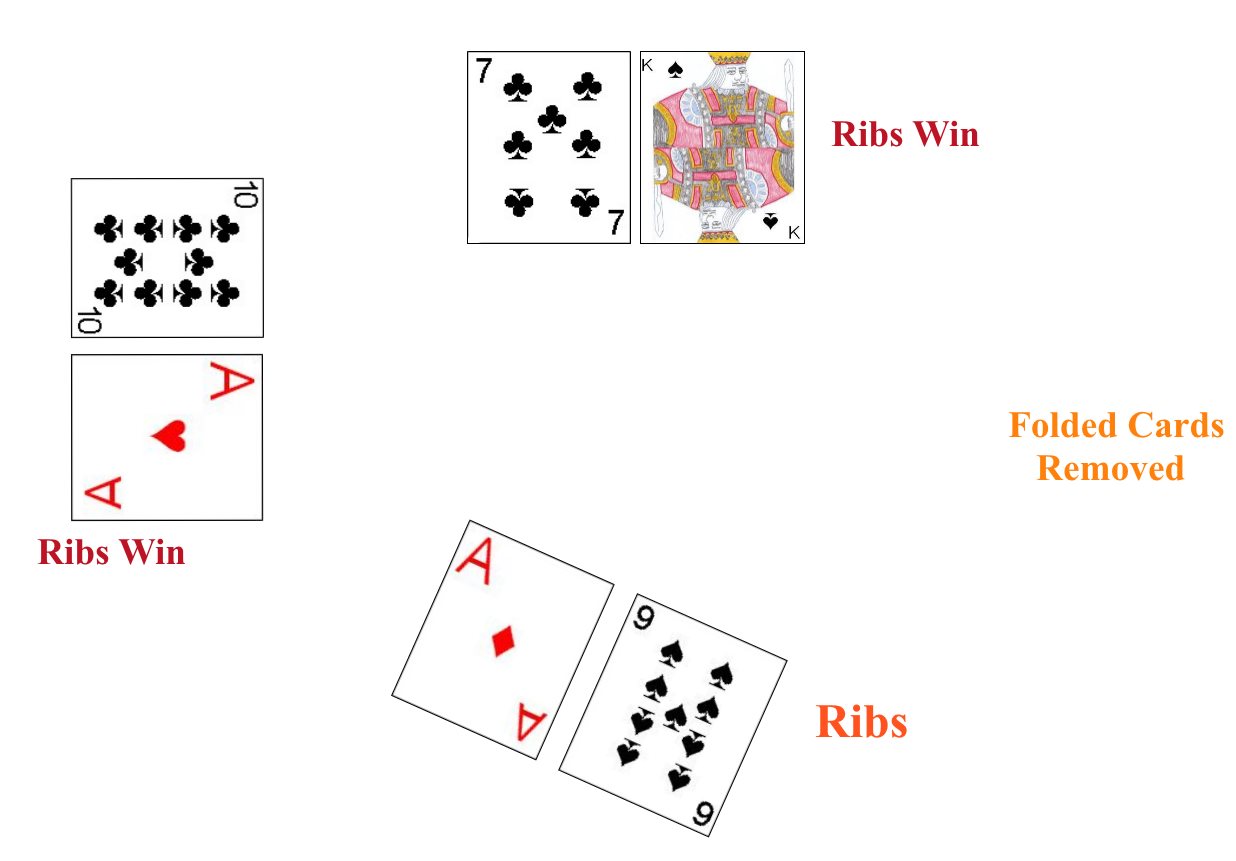The number of cards and the makeup of the deck is directly dependent on the number of players. For each active participant in the game, the cards from 7 to Ace are added to the deck in one suit. Thus, for example, in a 5 player game, five sequences of eight cards would be included. It should be noted that with more than four players, cards from multiple standard decks will be needed to create the deck needed to play this game. While the suits of the cards are irrelevant, each card does have a relative ranking as follows (from high to low); Ace, King, Queen, Jack, 10, 9, 8, 7. In addition to a ranking, each card has a point value which is used for scoring each round and hand. The following chart shows the scoring value of each card in the deck:
|
 |
Determination of seating positions and first dealer can be performed using a variety of methods, with drawing for high cards commonly performed. Using this method, each player should draw one card from the shuffled, face-down deck. The player who draws the highest card would have first choice of seats at the table, and each additional player taking a remaining seat in the order of ranking of cards drawn, from highest to lowest. The player drawing the highest card of all would be set as the first dealer. After each hand, the role of the dealer rotates in a clockwise direction around the table.
After the players are seated and the first dealer is determined, the dealer should thoroughly shuffle the deck and then offer it to the player at his right to cut. The Dealer completes the cut and then begins dealing the cards, starting with the player at his immediate left. He deals the cards in packets of two face-down cards to each player in a clockwise direction around the table until each player has a total of eight cards. After the deal has been completed, each player then picks up his hand to examine it.
 Bidding: Unlike in most games, in Ribs, there is a round of bidding
before every trick. A bid is a player's declaration of the number of
points (or more) in cards from other players he believes he can win on
the trick. On the first trick of each hand, the dealer makes the first
bid. After the first trick of each hand, the bidding for the next trick
is begun by the high bidder from the previous trick. The first bidder of a hand must make a minimum bid of 2. After this, the bidding continues in a clockwise rotation around the table from player to player. A player must either make a bid of 1 point higher then the previous bid or pass. Once a player passes, he may make no further bids for the current trick. The bidding continues until all players but one have passed. The player who made the highest bid on this trick is the Leader for this trick.
Bidding: Unlike in most games, in Ribs, there is a round of bidding
before every trick. A bid is a player's declaration of the number of
points (or more) in cards from other players he believes he can win on
the trick. On the first trick of each hand, the dealer makes the first
bid. After the first trick of each hand, the bidding for the next trick
is begun by the high bidder from the previous trick. The first bidder of a hand must make a minimum bid of 2. After this, the bidding continues in a clockwise rotation around the table from player to player. A player must either make a bid of 1 point higher then the previous bid or pass. Once a player passes, he may make no further bids for the current trick. The bidding continues until all players but one have passed. The player who made the highest bid on this trick is the Leader for this trick.
To begin a trick, the Leader selects any two cards from his hand (called the Ribs) and places them face-down on the table. After doing so, each other player, in a clockwise direction after the dealer, plays two cards of his own to the table. A player is entitled to play any two cards of his choice from his hand. These cards are usually played face-up. However, once each hand, a player (who is not the leader) is entitled to fold. This consists of playing his cards face-down to the table. These folded cards are not considered for the hand and cannot be won or captured by any player.
After each player has played two cards to the trick, the trick is then examined and scored. First, any folded cards are removed from the trick and discarded to the side. These cards are won by no one. Then, the Ribs must be exposed and each pair of cards played by each other player is compared to the two Rib cards, which this result of each comparison determining the scoring result for the trick:
- If any player other than the Leader has played two cards of the same ranks as the Ribs, that player instantly wins the trick. If multiple players play cards that match both cards comprising the Ribs, whichever of these players who played earliest to this trick is the winner. A winner of a trick in this way captures all the face-up cards on the table that are part of this trick (minus any folded cards which should have already been set aside). Captured cards should be kept in a captured card pile for scoring at the end of the hand. In this event, since all the cards have been captured for this trick, the trick ends and bidding for the next trick begins.
- If neither of a player's played cards are of the same rank as either of the Rib cards, and at least one of these cards is higher than the highest card in the Ribs, this player beats the Ribs. In this case, he is entitled to immediately capture his own two played cards, adding them to his own capture pile.
- If neither of a player's played cards matches either cards of the Rib cards, but the highest card in the Ribs is higher than either of these played cards, these cards have been beaten by the Ribs and remain face-up on the table.
- If exactly one of a player's played cards matches one of the Rib cards, the Ribs automatically beat these cards, regardless of the rank of the cards. These cards are thus then left face-up on the table.
 After all cards have been compared and either beat the Ribs (and thus captured by the player) or beaten by the Ribs and remaining on the table, the total value of card points for cards remaining on the table (excluding the Ribs) is summed. If this number is equal to or greater than the bid by the Leader, that player is entitled to capture all the face-up cards on the table (including the Ribs themselves). However, if the total value in cards beat by the Ribs is less than his bid, each other player is entitled to capture his own cards played to the trick, and the Ribs are set aside in the discard pile, scored by no one.
After all cards have been compared and either beat the Ribs (and thus captured by the player) or beaten by the Ribs and remaining on the table, the total value of card points for cards remaining on the table (excluding the Ribs) is summed. If this number is equal to or greater than the bid by the Leader, that player is entitled to capture all the face-up cards on the table (including the Ribs themselves). However, if the total value in cards beat by the Ribs is less than his bid, each other player is entitled to capture his own cards played to the trick, and the Ribs are set aside in the discard pile, scored by no one.
The game continues for a total of four tricks, after which the players total up the number of card points for cards in his own capture pile. Whichever player has managed to capture the most points earns one Game Point. If multiple players tie for the most points during the hand, each of these tying players scores one Game Point. The first player to earn five Game Points is declared the overall session winner.